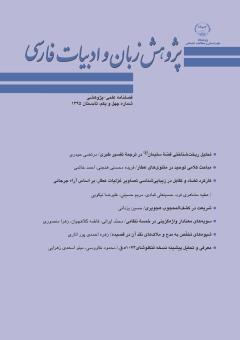تحلیل ریختشناختی قصّة سلیمان(ع) در ترجمة تفسیر طبری
محورهای موضوعی : پژوهشهای ادبیات کلاسیک ایران
1 - استادیار گروه زبان و ادبیات فارسی، دانشگاه پیام نور
کلید واژه: قرآن سلیمان(ع) ترجمة تفسیر طبری پراپ ریختشناسی,
چکیده مقاله :
در پژوهش حاضر قصّة سلیمان(ع) که از شناخته شده ترین قصّههای دینی در جهان است و در ترجمة تفسیر کهن طبری هم روایت شده، بر پایة نظریّة ریختشناسی «پراپ» ارزیابی شده است. در این قصّه، شمارگان شخصیت ها و خویش کاری های آنها با چارچوب نظریّة پراپ و تبصره های نظریّة او، همخوانی بسیار نزدیکی داشته و هر سه حرکت قصّه، حرکت هایی از گونة نخست الگوهای حرکتی شش گانة پراپ را نمایش داده اند. از آنجا که نظریّة پراپ بر پایة مقایسة ساختار قصّه های پریان روسی سامان پذیرفته و به شاخ و برگ های کمّیت زای قصّه ها چندان توجّهی نداشته، در مطالعة قصّه ای از ردة قصّه های قرآنی نیز سودمند واقع شده است. حوادثی که در قصّة سلیمان(ع) اتّفاق افتاده، بسیار مشابه حوادث قصّههای پریان است و نویسنده را بر آن داشته تا دادوستد های تاریخی میان این دو قصه را نتیجه گیری کند.
In this research the story of Solomon (pbuh), one of the well-known religious stories in the world that has also been narrated in Tarjomeh-ye Tafsir-e-Tabari (Persian translation of Tabari’s commentary of Quran) is analyzed and evaluated based on Propp’s morphology of the Folktale. The number of characters and their functions in this story are in accordance with the framework and notes of Propp’s model, and all of the three movements of the story have displayed the patterns suggested as the first of the sextet movement patterns of this model. Since Propp’s theory has been organized by studying the structures of the Russian fairy tales and pays less attention to cumulative embellishments in the tales, it is proved to be useful in studying Quranic stories. The events happened in Solomon (pbuh) story, are too similar to fairy tale events and based on that the author came to the conclusion that there is historical intertextual relationship between them.

